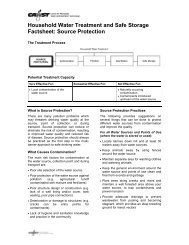Greywater Management in Low and Middle-Income Countries - SSWM
Greywater Management in Low and Middle-Income Countries - SSWM
Greywater Management in Low and Middle-Income Countries - SSWM
Create successful ePaper yourself
Turn your PDF publications into a flip-book with our unique Google optimized e-Paper software.
<strong>Greywater</strong> temperature is often higher than that of the water supply <strong>and</strong> varies<br />
with<strong>in</strong> a range of 18–30 o C. These rather high temperatures are attributed to the<br />
use of warm water for personal hygiene <strong>and</strong> discharge of cook<strong>in</strong>g water. These<br />
temperatures are not critical for biological treatment processes (aerobic <strong>and</strong><br />
anaerobic digestion occurs with<strong>in</strong> a range of 15–50 o C, with an optimal range of 25–<br />
35 o C) (Crites <strong>and</strong> Tchobanoglous, 1998). On the other h<strong>and</strong>, higher temperatures<br />
can cause <strong>in</strong>creased bacterial growth <strong>and</strong> decreased CaCO 3<br />
solubility, caus<strong>in</strong>g<br />
precipitation <strong>in</strong> storage tanks or pip<strong>in</strong>g systems.<br />
<br />
<br />
lead to high solids content <strong>in</strong> greywater. These particles <strong>and</strong> colloids cause turbidity<br />
<br />
<br />
nylon, polyethylene), powdered detergents <strong>and</strong> soaps, as well as colloids are the<br />
ma<strong>in</strong> reasons for physical clogg<strong>in</strong>g. Suspended solids concentrations <strong>in</strong> greywater<br />
range from 50–300 mg/l, but can be as high as 1,500 mg/l <strong>in</strong> isolated cases (Del<br />
Porto <strong>and</strong> Ste<strong>in</strong>feld, 1999). The highest concentrations of suspended solids are<br />
typically found <strong>in</strong> kitchen <strong>and</strong> laundry greywater. Suspended solids concentrations<br />
strongly depend on the amount of water used. Observations <strong>in</strong> Nepal, Malaysia,<br />
Israel, Vietnam, <strong>and</strong> the United States revealed average suspended solids loads<br />
of 10–30 g/p/d (see Table 3-3), contribut<strong>in</strong>g to 25–35% of the total daily suspended<br />
solids load <strong>in</strong> domestic wastewater, <strong>in</strong>clud<strong>in</strong>g toilet wastewater (Led<strong>in</strong> et al., 2001).<br />
<br />
The chemical parameters of relevance are hydrochemical parameters such as<br />
pH, alkal<strong>in</strong>ity, electrical conductivity, sodium adsorption ratio (SAR), biological <strong>and</strong><br />
chemical oxygen dem<strong>and</strong> (BOD, COD), nutrient content (nitrogen, phosphorous),<br />
<strong>and</strong> problematic substances such as heavy metals, dis<strong>in</strong>fectants, bleach, surfactants<br />
or organic pollutants <strong>in</strong> detergents.<br />
pH <strong>and</strong> alkal<strong>in</strong>ity<br />
The pH <strong>in</strong>dicates whether a liquid is acidic or basic. For easier treatment <strong>and</strong> to<br />
avoid negative impacts on soil <strong>and</strong> plants when reused, greywater should show a<br />
pH <strong>in</strong> the range of 6.5–8.4 (FAO, 1985; USEPA, 2004). The pH value of greywater,<br />
which strongly depends on the pH value of the water supply, usually lies with<strong>in</strong> this<br />
<strong>Greywater</strong> Characteristics<br />
10
















